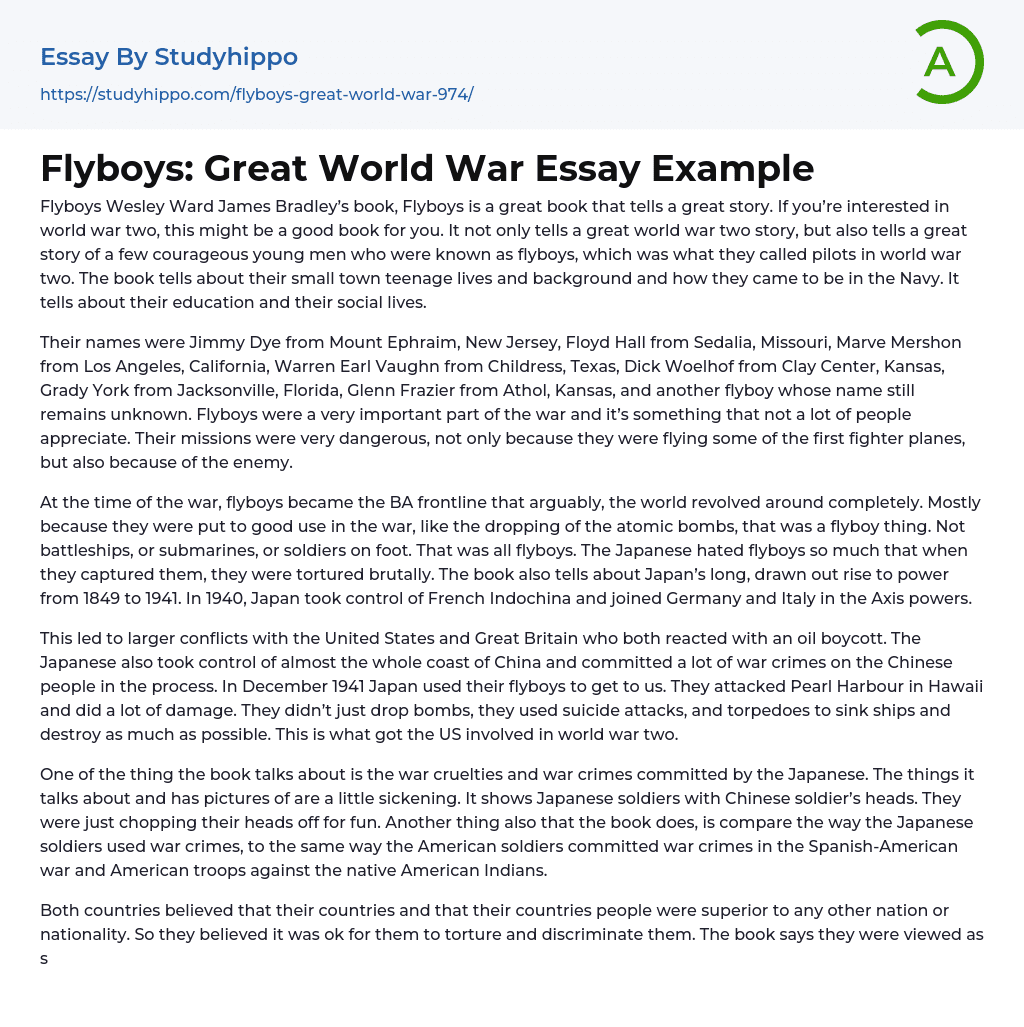Flyboys Wesley Ward James Bradley’s book, Flyboys is a great book that tells a great story. If you’re interested in world war two, this might be a good book for you. It not only tells a great world war two story, but also tells a great story of a few courageous young men who were known as flyboys, which was what they called pilots in world war two. The book tells about their small town teenage lives and background and how they came to be in the Navy. It tells about their education and their social lives.
Their names were Jimmy Dye from Mount Ephraim, New Jersey, Floyd Hall from Sedalia, Missouri, Marve Mershon from Los Angeles, California, Warren Earl Vaughn from Childress, Texas, Dick Woelhof from Clay Center, Kansas, Grady York from Jacksonville, Florida, Glenn Frazier from Athol
..., Kansas, and another flyboy whose name still remains unknown. Flyboys were a very important part of the war and it’s something that not a lot of people appreciate. Their missions were very dangerous, not only because they were flying some of the first fighter planes, but also because of the enemy.
At the time of the war, flyboys became the BA frontline that arguably, the world revolved around completely. Mostly because they were put to good use in the war, like the dropping of the atomic bombs, that was a flyboy thing. Not battleships, or submarines, or soldiers on foot. That was all flyboys. The Japanese hated flyboys so much that when they captured them, they were tortured brutally. The book also tells about Japan’s long, drawn out rise to power from 1849 to 1941. In 1940, Japa
took control of French Indochina and joined Germany and Italy in the Axis powers.
This led to larger conflicts with the United States and Great Britain who both reacted with an oil boycott. The Japanese also took control of almost the whole coast of China and committed a lot of war crimes on the Chinese people in the process. In December 1941 Japan used their flyboys to get to us. They attacked Pearl Harbour in Hawaii and did a lot of damage. They didn’t just drop bombs, they used suicide attacks, and torpedoes to sink ships and destroy as much as possible. This is what got the US involved in world war two.
One of the thing the book talks about is the war cruelties and war crimes committed by the Japanese. The things it talks about and has pictures of are a little sickening. It shows Japanese soldiers with Chinese soldier’s heads. They were just chopping their heads off for fun. Another thing also that the book does, is compare the way the Japanese soldiers used war crimes, to the same way the American soldiers committed war crimes in the Spanish-American war and American troops against the native American Indians.
Both countries believed that their countries and that their countries people were superior to any other nation or nationality. So they believed it was ok for them to torture and discriminate them. The book says they were viewed as subhuman. Flyboys were needed because of the way the Japanese fought. They used suicide bombing tactics and would not give up and they just plain outnumbered us. The United States soldiers invaded Iwo Jima in 1945. At the
same time, the warplanes bombed the small communications outpost on Chichi Jima.
Iwo Jima had about 22,000 Japanese soldiers. Chichi Jima had about 25,000 Japanese soldiers. Iwo Jima was considered easier to fight at because of the fact that it had flat areas; Chichi Jima was very hilly and would have been hard to fight. This is where the flyboys came in. Instead of using ground forces at Chichi Jima, they just sent in the flyboys and air raided the island. There was a quote in the book from a Marine, “Iwo was hell. Chichi would have been impossible. In the air raid, there were planes that were shot down, and nine crewmen survived. One of the crewmen was George H. W. Bush, who would go on to be president. The other eight were captured by the Japanese soldiers. The book tells the story of these eight American soldiers who had to suffer some of the worst brutality in life and in death from the Japanese captors. A fact that remained hidden for a long time after the incident is that the prisoners of war were eaten by the Japanese soldiers.
- Non-Commissioned Officer essays
- Business Law essays
- Contract essays
- Consumer Protection essays
- Property essays
- Ownership essays
- Agreement essays
- Common Law essays
- Contract Law essays
- Justice essays
- Security essays
- Tort Law essays
- United States Constitution essays
- Crime essays
- Lawsuit essays
- Treaty essays
- Family Law essays
- Marijuana Legalization essays
- Constitution essays
- War on Drugs essays
- Court essays
- Jury essays
- Police essays
- Protection essays
- Community Policing essays
- Criminal Law essays
- Judge essays
- Lawyer essays
- Employment Law essays
- Copyright Infringement essays
- Injustice essays
- Intellectual Property essays
- Breach Of Contract essays
- Jurisprudence essays
- Social Injustice essays
- Juvenile Justice essays
- Internet Privacy essays
- Cyber Security essays
- Bill Of Rights essays
- Civil Liberties essays
- First Amendment To The United States Constitution essays
- Fourth Amendment To The United States Constitution essays
- Second amendment essays
- Animal Cruelty essays
- Law Enforcement essays
- Juvenile Justice System essays
- Surveillance essays
- Forensic Science essays
- Crime Prevention essays
- Criminal Justice essays




